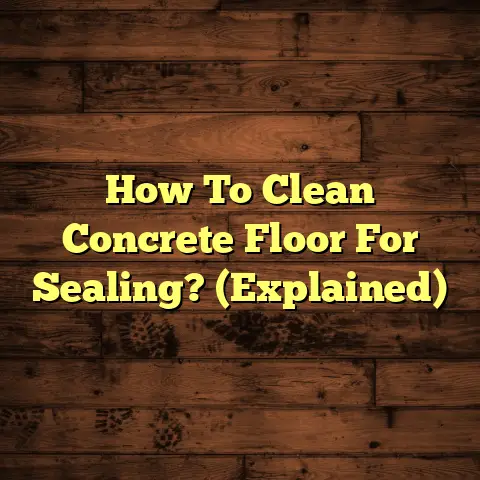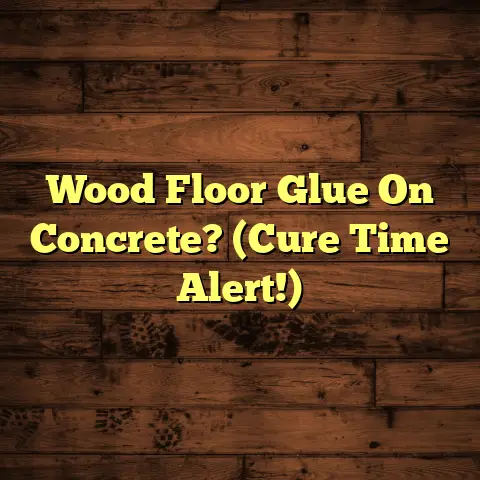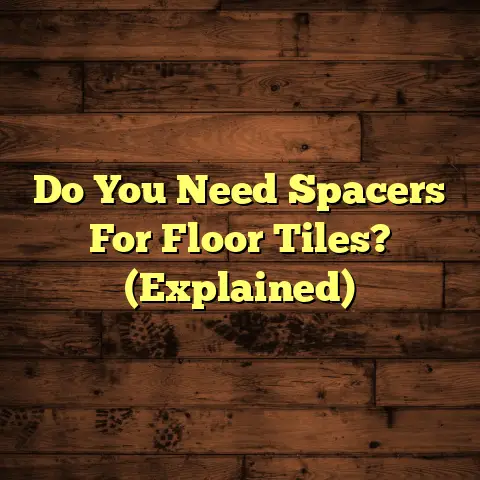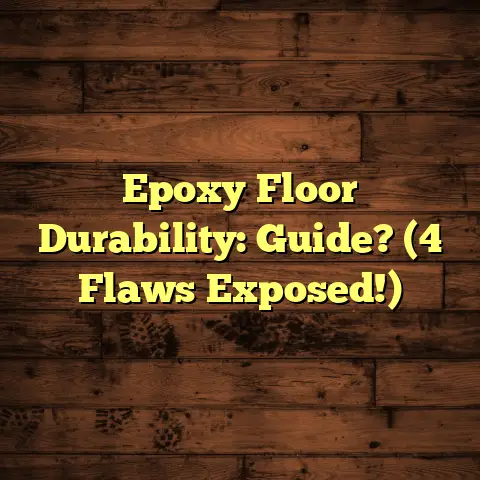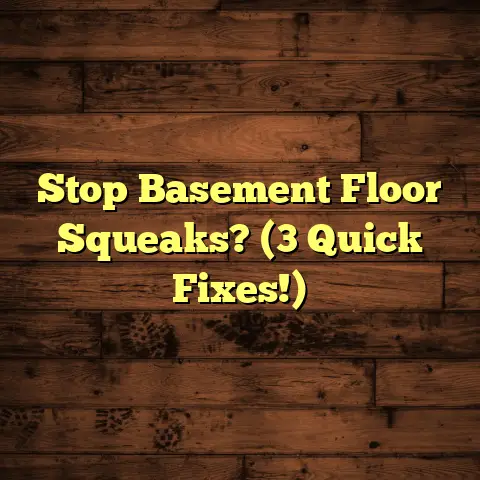Remove Scuffs From Concrete (Fast DIY Guide!)
I get it.
As a flooring contractor for over 15 years, I’ve seen it all.
Scuffs are like uninvited guests – they show up unexpectedly and can really mess with the overall look of a space.
Imagine this: You’ve just finished setting up your dream home gym in the basement.
New equipment, motivational posters, the works!
But then, bam!
There they are – black streaks and smudges from moving the treadmill.
Or picture a bustling retail store, sleek and modern, designed to impress customers.
But the constant foot traffic leaves behind a trail of scuffs, making the place look worn and tired.
It’s frustrating, right?
Those scuffs can really detract from the aesthetic appeal of a space and, believe it or not, can even affect property value.
The good news?
You don’t have to live with them!
And you definitely don’t need to call in a professional (unless you really want to!).
I’m going to walk you through a fast, effective DIY guide to removing scuffs from concrete, so you can get your floors looking pristine again in no time.
Understanding Concrete Scuffs
First things first, let’s talk about what causes those pesky scuff marks in the first place.
Think of it like this: concrete is tough, but it’s not invincible.
What Causes Scuff Marks?
Rubber Soles: This is the most common culprit.
Those black streaks you see?
Often from the rubber on shoes, especially work boots or athletic shoes.-
Furniture Movement: Dragging chairs, tables, or other heavy items across the floor can leave behind scuffs and scratches.
-
Heavy Equipment: Think dollies, hand trucks, or even vehicle tires (especially in garages).
-
Dirt and Grit: Tiny particles of dirt and grit can get trapped under shoes or furniture and act like sandpaper, scratching the surface.
Concrete Composition and Porosity
Concrete is essentially a mixture of cement, water, and aggregates (like sand and gravel).
It’s a porous material, meaning it has tiny pores or holes that can trap dirt and stains.
This porosity is important because it affects how easily scuffs can be removed.
A sealed concrete floor will be less porous and easier to clean than an unsealed one.
Think of it like a sponge.
A dry sponge soaks up everything, while a wet sponge repels liquid.
Tools and Materials Needed
Okay, now that we know what we’re up against, let’s gather our supplies.
Here’s a comprehensive list of everything you’ll need:
- Broom and Dustpan: For the initial cleaning.
- Bucket and Mop: For washing the surface.
- Scuff Eraser Sponges or Pads: These are lifesavers!
I personally recommend the Mr. Clean Magic Eraser. - Vinegar, Baking Soda, or Commercial Concrete Cleaners: We’ll talk about these in more detail later.
- Soft-Bristle Brush or Scrub Brush: For scrubbing stubborn scuffs.
- Water: For rinsing.
- Towels: For drying. Microfiber towels work best.
- Sealer (Optional): To protect your clean floor from future scuffs.
Step-by-Step Guide to Removing Scuffs
Alright, let’s get down to business!
Here’s my tried-and-true method for removing scuffs from concrete:
1. Preparation
The first step is to clear the area.
Move any furniture, rugs, or other obstacles out of the way.
Then, grab your broom and dustpan and give the floor a good sweep to remove any loose dirt, dust, or debris.
2. Initial Cleaning
Next, we need to wash the floor to remove any surface dirt and grime.
You can use a simple solution of warm water and a mild dish soap.
Alternatively, you can use a commercial concrete cleaner.
Just follow the manufacturer’s instructions.
Mop the floor thoroughly, making sure to get into all the nooks and crannies.
3. Testing the Scuff Removal Method
Before you start scrubbing away at all the scuffs, it’s a good idea to test your chosen cleaning agent or tool in an inconspicuous area.
This will help you avoid any potential damage or discoloration.
Choose a small, out-of-the-way spot, like a corner or under a piece of furniture.
Apply your cleaning solution or use your scuff eraser pad and see how the concrete reacts.
If everything looks good, you can move on to the next step.
4. Scuff Removal Techniques
This is where the magic happens!
Here are a few different techniques you can use to remove scuffs:
Using Scuff Eraser Pads or Sponges: These are my go-to for light to moderate scuffs.
Simply wet the pad and gently rub it over the scuff mark.
You’ll be amazed at how easily they lift away.I like to use the Mr. Clean Magic Eraser.
They are cheap, and last a long time.DIY Solutions:
-
Baking Soda Paste: Mix baking soda with a little water to form a thick paste.
Apply the paste to the scuff mark and let it sit for a few minutes.
Then, scrub with a soft-bristle brush and rinse with water. -
Vinegar Solution: Mix equal parts white vinegar and water in a spray bottle.
Spray the solution onto the scuff mark and let it sit for a few minutes.
Then, scrub with a soft-bristle brush and rinse with water.
-
Commercial Cleaners: There are many commercial concrete cleaners available that are specifically designed for removing scuffs and stains.
Follow the manufacturer’s instructions carefully.
Important Note: When using any cleaning solution, always wear gloves to protect your hands.
5. Final Cleaning
Once you’ve removed all the scuffs, it’s time for a final cleaning.
Rinse the floor thoroughly with clean water to remove any remaining cleaning solution.
Then, dry the floor with clean towels. This will help prevent water spots.
Pro Tip: Use a fan to speed up the drying process.
Preventive Measures
Okay, you’ve got your concrete floors looking spick and span.
Now, let’s talk about how to keep them that way!
Here are a few easy preventive measures you can take to minimize future scuffs:
- Use Furniture Pads: Place felt pads under the legs of all your furniture to prevent scratching and scuffing.
- Avoid Certain Footwear Inside: Encourage family members and guests to remove their shoes or wear soft-soled slippers inside.
- Regular Cleaning: Sweep or vacuum your concrete floors regularly to remove dirt and grit that can cause scratches.
Apply a Sealant: Applying a concrete sealant will create a protective barrier that will help prevent scuffs and stains.
There are two main types of concrete sealers: penetrating sealers and topical sealers.
Penetrating sealers soak into the concrete and create a water-repellent barrier.
Topical sealers form a film on the surface of the concrete.I generally recommend applying a sealant every 1-3 years, depending on the level of traffic.
Special Cases
Sometimes, scuffs can be more difficult to remove.
Here are a few special cases and how to deal with them:
- Older Concrete: Older concrete may be more porous and more difficult to clean.
You may need to use a stronger cleaning solution or a more abrasive scrubbing tool. - Tire Marks: Tire marks can be particularly stubborn.
Try using a commercial tire mark remover or a degreaser. - Paint Scuffs: Paint scuffs can be removed with a paint thinner or a paint remover.
Be careful not to damage the concrete.
Conclusion
So there you have it!
A comprehensive guide to removing scuffs from concrete.
With the right tools and techniques, you can easily restore your concrete floors to their original pristine condition.
Remember, maintaining your concrete surfaces is important for both aesthetic and practical reasons.
Not only will it make your space look more attractive, but it will also help protect your investment and extend the life of your floors.
And the best part? It’s a DIY project that anyone can tackle!
Call to Action
Now, I want to hear from you!
Have you tried any of these methods for removing scuffs from concrete?
Do you have any other tips or tricks to share?
Leave a comment below and let me know!
Let’s create a community of DIY enthusiasts who are passionate about keeping their concrete floors looking their best.
